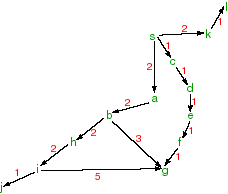
Suppose the neighbours are given by the following relations:
Suppose the heuristic estimate of the distance to g is:neighbours(s,[a,c,k]). neighbours(a,[b]). neighbours(b,[h,g]). neighbours(c,[d]). neighbours(d,[e]). neighbours(e,[f]). neighbours(f,[g]). neighbours(g,[]). neighbours(h,[i]). neighbours(i,[j]). neighbours(j,[]). neighbours(k,[l]). neighbours(l,[]).
For each of the following search strategies to find a path from s to g:h(a,2). h(b,3). h(c,4). h(d,3). h(e,2). h(f,1). h(g,0). h(h,4). h(i,5). h(j,6). h(k,5). h(l,6). h(s,4).
~cs322/tools/search/search.